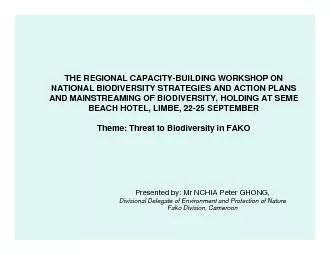/


INTRODUCTION ID: 822773
Download Pdf The PPT/PDF document "THE REGIONAL CAPACITY-BUILDING WORKSHOP ..." is the property of its rightful owner. Permission is granted to download and print the materials on this web site for personal, non-commercial use only, and to display it on your personal computer provided you do not modify the materials and that you retain all copyright notices contained in the materials. By downloading content from our website, you accept the terms of this agreement.
THE REGIONAL CAPACITY-BUILDING WORKSHOP
THE REGIONAL CAPACITY-BUILDING WORKSHOP ON NATIONAL BIODIVERSITY STRATEGIES AND ACTION PLANS AND MAINSTREAMING OF BIODIVERSITY, HOLDING AT SEME BEACH HOTEL, LIMBE, 22-25 SEPTEMBERTheme: Threat to Biodiversity in FAKOPresented by: Mr NCHIA Peter GHONG,Divisional Delegate of Environment and Protection of Nature Fako Division, CameroonINTRODUCTIONFako Division of the South West Province of Cameroon is a hot spot for biodiversity. Due to the presence of Mt Cameroon, the highest peak in West Africa, the division experiences all the major terrestrial ecosystems rain forest, mountain forest, savanna, semi-arid, arid and fresh water ecosystems w
ith their associated biodiversity. It al
ith their associated biodiversity. It also has marine and brackish water ecosystems with their associated biodiversity, as well, considering the fact that it is at the coast of the Atlantic Ocean. Some of the sites are relatively undisturbed and are a heaven to biodiversity. The Mt Cameroon Region, most of which is found in Fako Division, is home to about 49 endemic species with other threatened and critically endangered species. Besides the natural sites, Fako Division is also home to most of the plantations of the Cameroon Development Corporation which grows a variety of agricultural biodiversity.THREATSThe Division, like any other, is
experiencing changes in dynamics such a
experiencing changes in dynamics such as changes in human population, economic activities, technology as well as socio-political and cultural factors; which all tend to affect the number, variety and variability of living things. Some of the threats to biodiversity within the region include:Disappearing mangrove, felled for fuel wood and other uses;Expanding agricultural activities;Unsustainable harvesting techniques;Soil and water pollution through the indiscriminate use of agro-chemicals; Pollution of the marine environment with hydrocarbons from petroleum exploitation companies, vessels using the sea and companies with related acti
vities;Poor waste disposal systems;Bus
vities;Poor waste disposal systems;Bush fires; andNatural disasters such as the eruption of Mt Cameroon and landslides.ACTION TAKENAware of the afore-mentioned problems, the Government of Cameroon has demonstrated its concern and commitment to the protection of the number and different forms of life within thisarea in different ways. Some of these include: The creation of the Ministries of Environment and Protection of Nature; and Forestry and Wildlife; and the appointment of Divisional Delegates for the respective ministries, who implement and reinforce government policy on biodiversity protection at the divisional level;The creation
of forest reserves;The enactment and i
of forest reserves;The enactment and implementation of laws related to natural resources and environmental management. The creation of specialised institutions in the domain of biodiversity conservation, namely, the Limbe Botanic Garden and the Limbe Wildlife Centre;The gazettementof the Mt Cameroon Region as a National Park; The promotion of community forest management; and Contributions from both national and international NGOs, CBOsand Associations in the creation of environmental awareness amongst communities and conservation.CONCLUSIONGovernment efforts not withstanding, the achievement of the target of the Convention on Biologi
cal Diversity, to significantly reduce
cal Diversity, to significantly reduce the current rate of biodiversity loss as a contribution to poverty alleviationby 2010, within Fako Division remains a serious challenge. This stems from the difficulties encountered in the implementation and reinforcement of government policy on the protection of biodiversity. The difficulties range from budgetary constrains to institutional conflicts.I have the conviction that Fako Division will remain one of the hottest spots of biodiversity in Cameroon and the World at large, if the efforts of the Government of Cameroon could be complemented by other concerned parties.Thanks for your kind attent